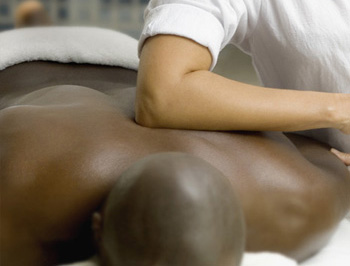Deep tissue massage is used for chronically tight or painful muscles, repetitive strain injury, postural problems or recovery from injury. It is especially helpful for chronically tense and contracted areas such as stiff necks, sore shoulders and lower back tightness.
Deep tissue massage focuses on the deeper layers of muscle tissue (mostly area specific) and fascia, also called connective tissue.
When there is chronic muscle tension or injury, there are usually bands of painful, rigid tissue in muscles and connective tissue. This can block circulation and cause pain, limited movement and inflammation. The massage physically breaks it down to relieve pain and restore normal movement and realigns muscle layers. It also helps alleviate muscle tension that is often a side effect of chronic pain by loosening the tight tissue clusters.
During the deep tissue massage fingertips, knuckles, hands, elbows and forearms are used. Some of the classic massage strokes are applied, but the movements are much slower and the pressure is deeper, concentrated on the areas of tension and pain.

Benefits of Deep Tissue Massage:
Unlike classic massage, which is used for relaxation, deep tissue massage usually focuses with success on a specific problem, such as:
- Chronic pain
- Break up scar tissue
- Limited mobility or stability
- Recovery from injuries
- Repetitive strain injury
- Postural problems
- Osteoarthritis pain
- Fibromyalgia
- Muscle tension or spasm
According to the August 2005 issue of “Consumer Reports magazine”, 34,000 people ranked deep tissue massage more effective in relieving osteoarthritis pain than physical therapy, exercise, prescription medications, chiropractic, acupuncture, diet, glucosamine and over-the-counter drugs.
Deep tissue massage also received a top ranking for fibromyalgia pain. People often notice improved range of motion immediately after a deep tissue massage.
What can I expect during my visit?
It is likely to be a bit more uncomfortable than a classic massage. At certain moments during the massage, people find there is usually some discomfort and pain, due to the “ungluing” and trigger points pressure. There is usually some soreness or tiredness after a deep tissue massage, but this normally subside within a day.
It's important to be realistic about what can be achieved with deep tissue massage. Many people have the wrong assumption that by asking the therapist to apply more pressure during the massage they will get get rid of all their knots in one hour. I wish it was so simple.
In fact, undoing chronic adhesions and tension built up over years is a more complex process and is best achieved by using an integrated program that includes exercise, working on posture and ways of moving, relaxation techniques and a regular massage program.
